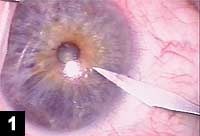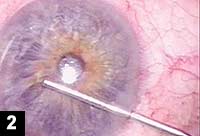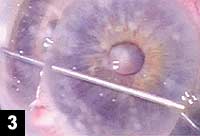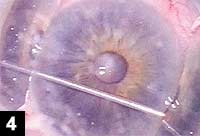Excimer laser trabeculotomy a viable option for skilled surgeons
The technique requires good coordination between the movements of the laser probe and the inverted three-dimensional image provided by the goniolens.
ROME – Ab interno excimer laser trabeculotomy is a promising option in the treatment of primary open-angle glaucoma, according a surgeon speaking here.
“The procedure is fast and effective, and doesn’t preclude the possibility of additional medical or surgical treatments. However, we shouldn’t forget that it is an invasive technique that may be a cause of cataract formation. It is quite expensive and difficult to learn, even for experienced surgeons,” said Silvia Babighian, MD, a research fellow at the Eye Clinic of Verona. Dr. Babighian spoke here at Rome 2002.
Excimer laser trabeculotomy (ELT) uses a wavelength of 308 nm to deliver energy to the anterior trabecular meshwork through a thin quartz probe bent at 65°.
“Unlike in most conventional procedures, the laser doesn’t convey heat; instead, it produces a series of 0.5-mm-diameter microablations that open up the Schlemm’s canal and allow the aqueous humor to flow out,” Dr. Babighian explained.
The procedure
The procedure is begun by performing a corneoscleral incision of 1.2 mm at 12 o’clock in the superonasal or superotemporal sector (figure 1). Viscoelastic is then injected into the anterior chamber to enlarge the spaces and protect the intraocular structures (figure 2). Next, the laser probe is inserted under microscopic control up to 2 mm from the trabecular meshwork, and a goniolens is applied to the cornea (figure 3). Laser energy is then delivered to the trabecular meshwork (figure 4). At the end of the procedure, the viscoelastic is removed and the anterior chamber thoroughly washed out.
|
“A variable number of four to eight spots, equally distributed over the anterior trabeculum, are usually sufficient to open the Schlemm’s canal and produce a good aqueous outflow. The spots must be at a distance of 500 µm from one another, which is equal to the external diameter of the probe. The spot diameter is 200 µm, and the time of exposure is 80 ns for each spot,” Dr. Babighian said.
The technique requires good coordination between the movements of the probe, which is seen directly, and the inverted three-dimensional image provided by the indirect goniolens. A direct goniolens may be used to allow straight visualization of the angle structures, but this requires an awkward tilting of the microscope, she said.
Encouraging results
Dr. Babighian discussed results of a study performed in collaboration with Alessandro Galan, MD, head of Sant’ Antonio Hospital in Padua, Italy. At the Sant’Antonio Hospital, 17 patients between 33 and 89 years of age (mean 72.5 ± 16.5 years) were treated with ELT for primary open-angle glaucoma (POAG). Nine of the patients who also had cataract were treated with a combined ELT-phaco procedure. The mean preoperative intraocular pressure (IOP) was 26.2 ± 3.2 mm Hg in the patients with POAG only, and 24.2 ± 2.5 mm Hg in those with glaucoma and cataract. The number of medications varied between 2 and 3 for all patients.
“Three months after the treatment, mean IOP was reduced by 8 mm Hg in both groups. Only in 6 cases did medical therapy have to be maintained, and no further surgery was necessary,” Dr. Babighian said.
During the procedure, a temporary IOP increase due to anterior chamber bleeding was seen in 58% of patients, but resolved spontaneously within a few days. One case of cataract occurrence was reported.
“ELT can be a valid alternative to medical therapy, to conventional laser trabeculotomy and to standard penetrating surgery. It is also fairly easy to combine with cataract surgery, but a higher number of patients and a longer follow-up are necessary for a more reliable evaluation of its efficacy,” she said.
For Your Information:
- Silvia Babighian, MD, can be reached at Ospedale Civile Sant’Antonio, Via Facciolati 121, Padua, Italy; (39) 049-8216780; fax: (39) 049-8216541; or at the Eye Clinic of the University of Verona, Via dell’Artigliere 8, 37129 Verona; (39) 045-8092340; e-mail: s.babighian@libero.it.
- Rome 2002, the 7th Annual Rome Symposium on Cataract, Refractive and Glaucoma Surgery, was sponsored jointly by Ocular Surgery News, the International Society of Refractive Surgery and the Italian Association of Cataract and Refractive Surgery.




